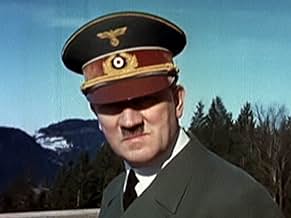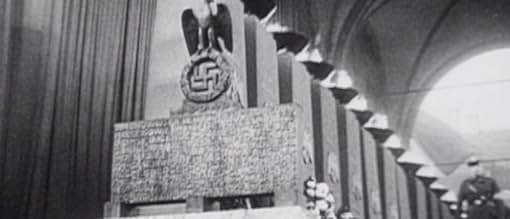La nazificazione della Germania dal 1933 al 1945 raccontata attraverso una raccolta di filmati nazisti, cinegiornali, film di propaganda e filmati amatoriali di Eva Braun.La nazificazione della Germania dal 1933 al 1945 raccontata attraverso una raccolta di filmati nazisti, cinegiornali, film di propaganda e filmati amatoriali di Eva Braun.La nazificazione della Germania dal 1933 al 1945 raccontata attraverso una raccolta di filmati nazisti, cinegiornali, film di propaganda e filmati amatoriali di Eva Braun.
Galeazzo Ciano
- Self
- (filmato d'archivio)
Albert Einstein
- Self
- (filmato d'archivio)
Joseph Goebbels
- Self
- (filmato d'archivio)
- (as Josef Goebbels)
Hermann Göring
- Self
- (filmato d'archivio)
Heinrich Himmler
- Self
- (filmato d'archivio)
Adolf Hitler
- Self
- (filmato d'archivio)
Benito Mussolini
- Self
- (filmato d'archivio)
Jesse Owens
- Self
- (filmato d'archivio)
Joachim von Ribbentrop
- Self
- (filmato d'archivio)
Recensioni in evidenza
10joel-28
Philippe Mora was the person who as a 19 year old film student discovered the now well known personal films of Eva Braun (that would make a fine film in itself). This fascinating color film footage is incorporated into this un narrated documentary along with a wide assortment of original Nazi newsreels and propaganda films to present life in Nazi Germany from 1933-45 as seen through the propaganda filmmakers (and Eva's) camera lens. A wonderful classical music score accompanies. This film is quite rare and is generally unavailable. I believe it was nominated for an award (or won an award). Nevertheless,if you get a chance to see it, buy it, etc, do it. It is the best documentary film on Nazi Germany of it's kind with much never before seen original footage.
10RandallB
This feature length documentary will knock your socks off ... if you're ever lucky enough to see it. If you have ever wondered how Hitler and his thugs wooed the Germans? Philippe Mora has assembled an incredible body of film footage here and let the material tell the story ... there is no narration, something Philippe does particularly well (see his next doco, BROTHER CAN YOU SPARE A DIME). He was even able to find Eva Braun's home movies of Hitler, mostly taken at Obersalzburg, and with the help of German lipreaders, bring them to life. Students of history will find it particularly enlightening. It is also horrifying. Most people didn't think Hitler was at all bad. Famous reporter Dick Brinkly singing the praises of Hitler in the mid 30s must be embarrassing. See it if you can. Pray it comes out on DVD one day.
I tripped over this movie late at night on Amazon on-demand video. I gotta tell you, it's definitely interesting. It shows the "human" side of Hitler, joking around with staff, making wise cracks here and there, complaining about cigarette smoke, etc. I think the intent of the story (which is basically newsreel and personal movie camera footage in order from 1935 to 1945) is to chronicle the rise and fall of Hitler, as seen in his eyes. You can see how the war wears on him- he gets grayer, starts shaking at times, and even see how he can't stand being in direct sunlight because of the drugs he was on. So, knowing his personal and physical history from what I've read before about the sick Bastard, this movie confirms those conclusions (i.e.- he was mentally ill and took large doses of drugs that blurred his speech, the way he walked, the way he interacted with others, etc. So, it's a good documentary from that end. Suggest watching with the volume down most of the time because hearing all the "Hiel Hitler!"s are enough to make you want to drink...
Nothing really new here for students of history. But for casual observers of world events who are not students of history, it may raise a few eyebrows. Lots of good footage and the Mora does a great job of not including unnecessary narration (the footage is painfully explicit on what happened (if not why it happened). Of course, the Versailles Treaty is not mentioned in detail; a major cause for the rise of Hitler because Germany was burdened with great war reparation debt from that treaty. This mightily led to Hitler's rise. Lesson? Reforming a country that loses a war is better than strangling it to a slow death. Nice home movie footage as well which tries to humanize Hitler. Good luck with that idea.
Because this documentary is centered on a place almost universally reviled by everyone on Earth, it was surprising to see it start off with quite a controversial statement. The opening slide states that if future historians demonize Hitler because of what he did, they're going to miss the entire point of the film, as it shows (largely through his eyes) what he really was: a human. This film, while basically just a large assortment of newsreels and footage from prewar Nazi Germany, surprised me more than a few times. With the Second World War being the historical subject I devote the most time to learning about, I wasn't expecting this movie to contain things I have never seen before. Most will be familiar with things like the huge rally in Nuremberg, as well as Neville Chamberlain professing to the British public Hitler won't fight England just because he signed a meaningless agreement. However, there's also scenes of propaganda minister Dr. Goebbels visiting Hitler at his mountain house in southern Bavaria. These types of clips tend to humanize Hitler and make him seem almost normal, which is probably why most people haven't seen them. I really did not expect to see Eva Braun saying how handsome she thinks Clark Gable is either. Her home movies taken at the Obersalzberg have been in countless ww2 documentaries, including what is probably the best one ever (World at War), but they never fail to be eerie to watch. We see her and her sister Gretl swim in a river, and later, she brings her scottish terriers to Hitler's house. Adolf reportedly didn't like Eva's dogs because they bit Blondi, his german shepherd. Ironically, one of her dogs was named Stasi, which would be the name of the postwar secret police in communist east germany. Another thing that caught my attention was taking a look inside the Reich Chancellery, which was the building Hitler commanded germany from. Aside from his office, pretty much the whole entire interior of the building looks like a 5 star hotel. Also shown is an art museum containing the works of National Socialist painters and sculptors, both trying their hardest to capture the perfect likeness of the Nordic race. One of Mussolini's in-laws is present at the opening ceremony. The statues in the museum are quite impressive, given that they were made in the 30s. One consisting of a man and his horse makes even Michaelangelo's David look tiny. The film includes some things that aren't really related to nazism, but were thrown in anyway simply because they occurred in germany. One of these is Einstein talking to an audience after he has learned the nazis want him out of germany. It never crossed my mind, but I think this is the first time I heard him talk. The documentary doesn't go into world war 2 itself, and only focuses on the period from 1933 to 39, but does jump ahead to 1945 at the end. This means it's nowhere near as comprehensive as something like World at War, which not only includes much of the same footage but also includes interviews with people who were within 5 feet of Hitler for much of his time as chancellor. While the footage of the 1936 Olympics, home movies and other things are enough to make the film passable in my eyes, it is hampered by a lack of substance to stand on. The footage is the only thing here telling the story. As a consequence, this will probably only please avid fans of this type of history, but it wasn't a problem for me. There's definitely a lot of things I never saw before, so it's excusable.
Lo sapevi?
- QuizThe provocative documentary was banned in Israel on the ground that it projects a sympathetic image of Adolf Hitler.
- ConnessioniFeatured in Krauts and Doubts: Swastika Revisited (2006)
I più visti
Accedi per valutare e creare un elenco di titoli salvati per ottenere consigli personalizzati
- How long is Swastika?Powered by Alexa
Dettagli
- Data di uscita
- Paese di origine
- Sito ufficiale
- Lingua
- Celebre anche come
- Swastika - hakkorset
- Azienda produttrice
- Vedi altri crediti dell’azienda su IMDbPro
- Tempo di esecuzione
- 1h 53min(113 min)
- Colore
- Mix di suoni
Contribuisci a questa pagina
Suggerisci una modifica o aggiungi i contenuti mancanti















